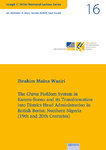- ISLAMWISSENSCHAFT
- ISLAMISCHE_STUDIEN
- JOSEPH C. MILLER MEMORIAL LECTURES SERIES
- ASIENWISSENSCHAFT
- ARCHÄOLOGIE ALS KULTURWISSENSCHAFT
- RELIGIONSWISSENSCHAFT
- RELIGIONSPÄDAGOGIK
- GESELLSCHAFT UND KIRCHE
- KIRCHE UND GEMEINDE
- GESUNDHEIT UND KRANKHEIT
- KINDERGARTENPÄDAGOGIK
- OPEN_ACCESS
- Neuerscheinungen
- In Vorbereitung
- News
- EBook
- Einzelkataloge
Categories JOSEPH C. MILLER MEMORIAL LECTURES SERIES Vol. 12: Mapping Conflict during the Era of the Slave Trade:
Vol. 12: Mapping Conflict during the Era of the Slave Trade:
Product no.: ISBN 978-3-86893-393-2
In stock
can be shipped within 3 days
36 pages, paperback
14,8 x 21,0, 2022
Labelled a crime against humanity by the United Nations in 2011, the slave trade and its legacy of bondage unfortunately continue to shape modern society through racism, discrimination, and unconscious bias. For those who were silenced, and for their descendants, there is little reconciliation. Without knowing their individual stories – where they came from, where they were taken – this part of human history remains a generalized story of mass atrocity, lacking details about the experiences of enslaved human beings. While historians have amassed data for over 12.5 million people involved in the Atlantic slave trade between 1500 and 1867, we have not been able to piece together enforced population movements from specific African places inland to slave ships at the coast. By applying methods from GIScience and spatial statistics, it is possible to learn about global migrations resulting from slavery within pre-colonial Africa. By extracting spatial data from primary and secondary sources, it is possible to design a spatial data repository and digital archive of pre-colonial African places with instances of conflict to operate on a temporal scale with Geographic Information Systems (GIS).
The Author:
Henry Lovejoy is an Assistant Professor and Director of the Digital Slavery Research Lab at the University of Colorado at Boulder. His book, Prieto: Yorùbá Kingship in Colonial Cuba during the Age of Revolutions, won the Chief Delano Book Prize for Yorùbá Studies. He is also co-editor of Liberated Africans and the Abolition of the Slave Trade, 1807–1896. He also sits on the board of directors for the Black American West Museum & Heritage Centre in Five Points, Denver.






































